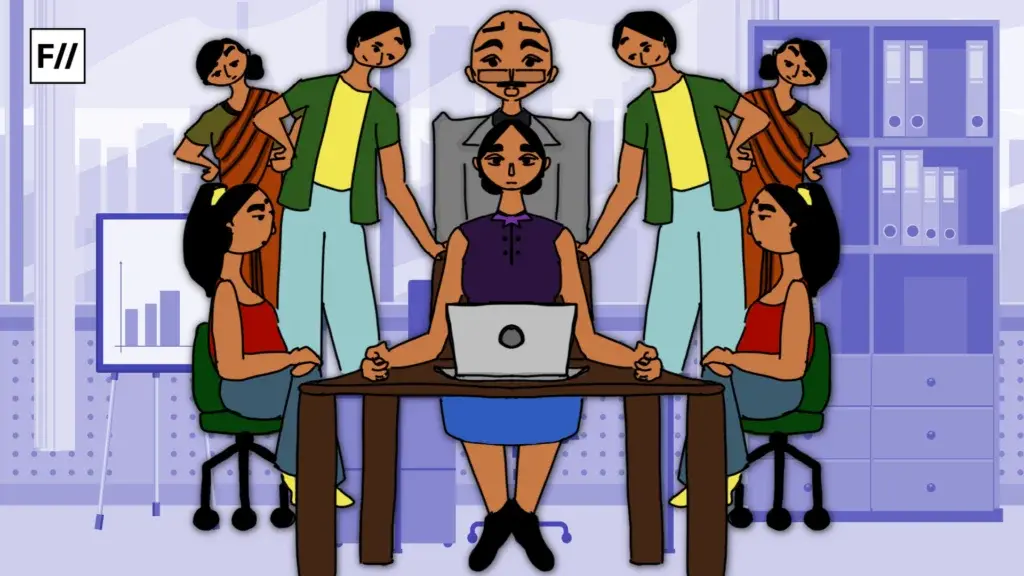A thriving economy is a result of a balanced and diverse workforce, driving great profits, and positively impacting organisations and indirectly, the society at large. A joint effort by LinkedIn India, and a public policy consulting firm, The Quantum Hub (TQH), the latest Economic Graph report highlights that the Indian corporate sector noticed an overall increase in women representation from 23.9% in 2016 to 26.8% in 2024.
Several studies also indicate that women-led businesses are holistically more purpose-driven, profitable, and successful, outperforming their peers.
Several studies also indicate that women-led businesses are holistically more purpose-driven, profitable, and successful, outperforming their peers. However, as per the report, progress in promoting women to senior leadership roles has been sluggish, with an increase from only 16.6% to 18.3% during this period. So if more women are entering the workforce, why aren’t there more women at the top as well?

But the more important question is, if women being in charge is overall an excellent idea for the business, economy, and society, why is India stuck under 19%? Let’s look at all levels of an organisation, starting from the top.
‘The landscape of corporate India has been rapidly evolving, and the role of women in this transformation is significant. However, despite the progress made, the journey for women to reach leadership positions remains fraught with hurdles.’ say Aditi Jha Board Member, LinkedIn India, and Aparajita Bharti Founding Partner, TQH Consulting in the Collaborative Foreword to the report.
Women’s representation in leadership roles varies significantly across sectors in India. Some sectors show better female representation in leadership. Professional Services and Entertainment Providers each have 22%, Administrative and Support Services and Hospitals and Health Care each have 23%, and Consumer Services have 25%. Government Administration has 29%, and Education leads with 30%.
Women’s representation in leadership roles varies significantly across sectors in India. Some sectors show better female representation in leadership.
However, we need to champion inclusion. This is especially true in certain industries like Construction, Oil, Gas, and Mining, Utilities, Wholesale, Manufacturing, Transportation, Logistics, Supply Chain and Storage, Real Estate and Equipment Rental Services. Each of these has only 11-14% women leaders.
Gaps that remain in the workforce
‘Gender bias, societal expectations, and structural barriers impede the progress of many talented women. These hurdles are also often sector-specific and manifest in different ways in different kinds of workplaces’ write Aparajita Bharti, Founding Partner, TQH Consulting and Aditi Jha, Board Member, LinkedIn India in the Collaborative Foreword.

Created by the United Nations Development Programme, the Gender Social Norms Index (GSNI), is a quantifiable measure of gender biases, evaluating people’s attitudes towards women across four crucial aspects: political, educational, economic, and physical integrity.
Shockingly, 75% of Indians exhibit gender bias in the economic aspect, as compared to 40% globally. This economic gender bias stems from the belief that men are more adept as business executives than women.
This bias, intentional or not, manifests into societal, organisational, familial, and personal obstacles, often forcing women out of the workforce, leaving those who overcome these challenges isolated in senior roles.
Women typically reach mid-level positions in their thirties. This is when marriage and family often make their careers harder.
Women typically reach mid-level positions in their thirties. This is when marriage and family often make their careers harder. If women take a break from their careers at this stage, responsibilities like taking care of their children and elder family members, along with organisational challenges such as loss of seniority or pay and lack of support upon return from leave are quite damaging.
This leaves little to no room for growth and promotion, causing a limited pool of women candidates to choose from, for leadership roles at the top. Also, the data shows an outdated hiring process. It relies heavily on traditional filters like employment history and education. This leads to missed chances to onboard diverse talent.
The leaky pipeline
LinkedIn’s Economic Graph data highlights a troubling trend in the career progression of women in India. Female representation in the workforce is 28.7% at the entry level and 29.5% at the senior individual contributor level. But it declines as women advance into higher managerial roles.

Specifically, women occupy only 18.5% of managerial positions. This percentage decreases further at the director level, where women constitute just 20.1%. The trend continues into senior executive roles where only 17.4% of women are Vice Presidents. A mere 15.3% reach C-suite positions.
This is often called the “leaky pipeline.” It is observed that women are well-represented in entry-level and senior contributor roles. Yet their numbers plummet as they climb the corporate ladder.
It is observed that women are well-represented in entry-level and senior contributor roles. Yet their numbers plummet as they climb the corporate ladder.
So statistically and evidently, more women are entering the workforce than ever before. Yet, they lack unbiased support, resources, inclusive governance, and mentorship, among other internal and external factors, to succeed.
Other factors holding women back in the workforce
Cultural conditioning and gender bias shape women’s perceptions of their abilities. Despite meeting job requirements, women often doubt themselves and don’t seek leadership roles. A 2022 ILSS study found over 50% of mid-senior women in the social sector felt hindered by self-limiting biases.
Another 2020 OECD report found that women often struggle to get selected for board positions due to non-transparent selection criteria, a lack of female role models, and informal board appointments often influenced by male-dominated networks and peer groups.

A recent CEDA report showed a shocking bias – 38% of HR managers considered marital status for women compared to only 22% for men.
‘Bridging this stark gender leadership gap requires a multi-stakeholder effort and targeted interventions to address structural barriers and nurture an inclusive talent pipeline.’ writes Mitali Nikore, the Founder of Nikore Associates
How the government is facilitating change
The 2013 Companies Act requires listed companies to have at least one woman on their boards, which has helped improve women’s representation. Follow-up regulations in 2014 and 2015 by SEBI have reinforced this rule.
Despite the Companies Act, enforcement remains inconsistent throughout. Between April 2018 and December 2023, ₹27 crore in fines was collected from 507 companies for non-compliance, indicating a sheer lack of outreach and awareness.
Industry initiatives to promote women leaders in the workforce
Industry groups and companies in India are also stepping up to improve gender diversity. The Standing Conference of Public Enterprises (SCOPE) is working to close the gender gap in public sector leadership. Big names like Accenture, Cognizant, L&T, PwC, Natwest Group, IKEA India, and KPMG are aiming for more women in leadership, with some targeting 50% by 2030. Additionally, Women in Big Data India (WiBD) is partnering with businesses to run programs that help women develop leadership skills.

‘Galvanizing the ecosystem can ensure that the next generation of women leaders rises to their full potential, driving India’s economy to new heights of success and sustainability.’ write Aparajita Bharti, Founding Partner, TQH Consulting and Aditi Jha, Board Member, LinkedIn India in the Collaborative Foreword.
The LinkedIn report recommends a way ahead
Women leaders are essential for enhancing business outcomes and promoting gender equality in organisations. Here are some key recommendations to boost women’s participation and promotion in leadership roles. The recommendations are for various sectors and are categorised by timeframe:
Long-term recommendations (5-10 years)
- Flexible or hybrid work policies: implement flexible or hybrid work arrangements.
- The goal is to enforce policies and laws strictly. They promote equity and end pay gaps.
- Paid Paternity Leave Policy: Introduce paid paternity leave to support shared family responsibilities.
- Revised Recruitment and Promotion Policies: Update the policies, helping women join leadership roles.
Medium-term recommendations (3-5 years)
- Government Initiatives for Board Diversity: Promote diversity in senior leadership by raising awareness about board diversity in listed companies.
- Mentorship and Leadership Development: Start mentorship and leadership programs at the government, organisational, and community levels.
- Data Collection and Monitoring: Ensure robust data collection on women’s career trajectories and maintain a national dashboard to track women’s leadership participation
Short-term recommendations (1-3 years)
- Networking and Support Groups: Establish networking and support groups tailored to women professionals aiming for leadership roles.
- Support for Returning Women: Provide extra support to women re-entering the workforce after career breaks due to personal care responsibilities.
- Skills-First Hiring Approach: Adopt a skills-first approach to hiring to emphasise candidates’ skills over traditional markers like employment history.
Ultimately, it all boils down to being fair, objective, respectful, and empathetic towards women as equals in society.

‘The main question we need to ask is ‘Are we building organizations that value women?’. If the organization isn’t wired to leverage feminine styles of leadership, women will continue to struggle to ‘fit in’ and run into barriers in attaining their full natural potential.’ says Sudha Srinivasan, CEO of The Nudge Centre for Social Innovation.
Indian society will shift when it realises that women bring a different and valuable view. Women are not there just because the law mandates it. They do not belong just in businesses, or just at homes, but at a national level.
Women are not there just because the law mandates it. Women do not belong just in businesses, or just at homes, but at a national level.
This is an opportunity to bring positive change, globally. If we want to get there, we can only do it together.
About the author(s)
Forget textbooks, Mrudavi got hooked on writing through her childhood obsession with fiction novels. Now, she tells engaging stories that address real-world topics with a touch of her experiences. When the writing bug takes a break, Mrudavi can be found curled up with a good book or with her favourite people, fueling her imagination with endless cups of iced lattes.





